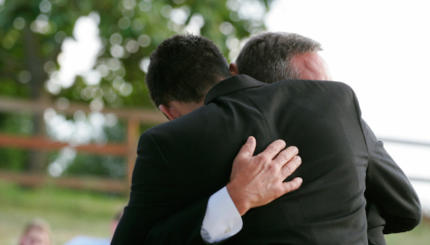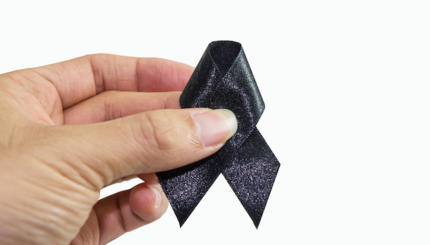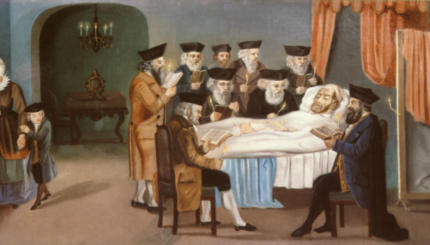Shiva is a period of mourning that generally lasts seven days, starting when the mourners return home from the funeral. During shiva, a mourner traditionally stays at home or at the home of the deceased or the home of other mourners, wears torn clothing or a torn black ribbon pinned to one’s clothes (a practice known as kriah) and doesn’t go to work or school. Find more details about kriah and other mourning practices.
What does a shiva house look like?
Traditionally, mourners cover all the mirrors in the house and sit either on low stools (in Ashkenazi tradition) or on the floors or on pillows (Sephardic tradition). Sitting like this symbolizes that the mourner is in low spirits. Mourners often keep a yahrzeit memorial candle burning for the entire week. In addition, it is customary to leave the doors unlocked so that visitors can come and go without disturbing the mourners. Many families also set out a condolence book where visitors can sign in and leave messages. Find more details about shiva house customs and what they signify.
When does one sit shiva and for whom?
Shiva begins immediately after the funeral. Traditionally, a mourner sits shiva for a parent, sibling, child or spouse.
How long does shiva last?
Shiva is the Hebrew word for “seven,” and shiva traditionally lasts seven days. Some families sit shiva for shorter periods of time, however. Jewish law stipulates that if a family is in financial distress, mourners can return to work after just three days. Learn more about work and shiva.

Help us keep Jewish knowledge accessible to millions of people around the world.
Your donation to My Jewish Learning fuels endless journeys of Jewish discovery. With your help, My Jewish Learning can continue to provide nonstop opportunities for learning, connection and growth.
When a yom tov, or Jewish holiday like Rosh Hashanah that is traditionally observed with restrictions similar to Shabbat restrictions (like not driving or using electricity), falls fewer than seven days after the burial, the shiva period is shortened, ending with the holiday. Shiva is not observed on Shabbat.
What is a mourner supposed to do during shiva?
Friends and family are expected to visit the mourner and provide food for him or her. Traditionally, three prayer services are conducted each day at the shiva house, with guests forming what is called a shiva (the prayer quorum of 10 adult Jews). During these services, mourners recite the Mourner’s Kaddish. Learn about the shiva minyan.
In addition, there are some shiva customs unique to the Sephardic community. For example, according to Ron Wolfson’s A Time to Mourn, A Time to Comfort, Iranian Jews customarily hold a special study session in synagogue during the shiva week, which mourners are allowed to attend “and are often joined by hundreds of friends and relatives.”
Besides staying home, are there other restrictions the mourner is supposed to observe during shiva?
Mourners are traditionally forbidden from working, shaving, bathing for pleasure, wearing leather shoes, having sex or cleaning their clothes during shiva. They are also supposed to refrain from pleasurable activities like listening to music, watching movies or other entertainment, or going to parties or other festive gatherings. According to some interpretations of Jewish law, mourners are not allowed to study Torah or other Jewish texts during shiva, except for texts pertaining to mourning. However, in many Sephardic communities, it is customary to study the Zohar, a mystical commentary on the Torah, throughout the week.
How does one pay a shiva visit?
Ideally you should find out beforehand during which hours the mourners want visitors, and, when you arrive, not say anything to the mourner(s) until he or she begins the conversation. Be careful not to tire the mourners, or engage them in small talk or conversation unrelated to their mourning.
Learn what NOT to say at a shiva. And find out 11 things you shouldn’t do at a shiva.
Bring food or, if possible, a full meal so the mourners won’t have to cook — but first check if the mourners keep kosher or have other dietary restrictions. Do not bring flowers, however. Upon leaving, it is customary to say, “May you be comforted from Heaven,” in the Sephardi tradition, or “May God console you together with everyone who mourns for Zion and Jerusalem,” in Ashkenazi tradition. Learn more about this phrase.
If you are comfortable doing so and are Jewish, you should participate in the shiva minyan so that the mourners will meet the prayer quorum of 10. (Be aware that if the mourners are Orthodox, only men will count in the minyan, but both men and women can still participate in the service.) Learn more about comforting mourners. Learn more about shiva etiquette.
What is the origin of shiva and other Jewish mourning practices?
According to the Talmud, the practice of sitting shiva is first alluded to early in the Torah, when Methuselah, the oldest man in the world, was mourned for seven days prior to the flood. Genesis 50:10 (in the Torah portion Vayechi) notes that Joseph “observed a mourning period of seven days” for his father, Jacob. Jewish mourning practices are discussed in the Talmud and clarified further in the Mishneh Torah, a compendium of Jewish law compiled by Maimonides in the 12th century, and the Yoreh De’ah section of the Shulchan Aruch, written by Joseph Caro in the 16th century.
How does shiva end?
The traditional end of shiva occurs on the seventh day of mourning (the sixth day after the funeral). The most common end-of-shiva practice today in many communities is for the mourner(s), on the morning of the last day of shiva, accompanied and even assisted by a friend or friends, to literally “get up from shiva.” The mourners rise from the low seat and confinement at home, and go for a walk around the block or its equivalent. In some communities, the friends recite the formula of consolation (“May God comfort you among all the mourners of Zion and Jerusalem”) and then say to the mourner(s), “Arise.” According to Ron Wolfson’s A Time to Mourn, Moroccan Jews end shiva with a special meal and study session, called a mishmara. Another mishmara, this time at the cemetery, takes place on the 30th day after burial.
At the end of shiva, mourners who, following traditional law, have not been wearing leather shoes now put on regular shoes, replace the torn clothing or torn cloth worn during shiva, and set out to encounter once again the world beyond the home. Learn more about ending shiva.
What happens after shiva?
The next phase of mourning is called sheloshim (pronounced shlo-SHEEM), Hebrew for 30, and it ends 30 days after burial. Sheloshim is less restrictive than shiva, however — mourners can go out, work and perform other everyday activities. Learn more about sheloshim.
Learn about the full timeline of Jewish mourning.
Sign up for a Journey Through Grief & Mourning: Whether you have lost a loved one recently or just want to learn the basics of Jewish mourning rituals, this 8-part email series will guide you through everything you need to know and help you feel supported and comforted at a difficult time.
Looking for a way to say Mourner’s Kaddish in a minyan? My Jewish Learning’s daily online minyan gives mourners and others an opportunity to say Kaddish in community and learn from leading rabbis.



